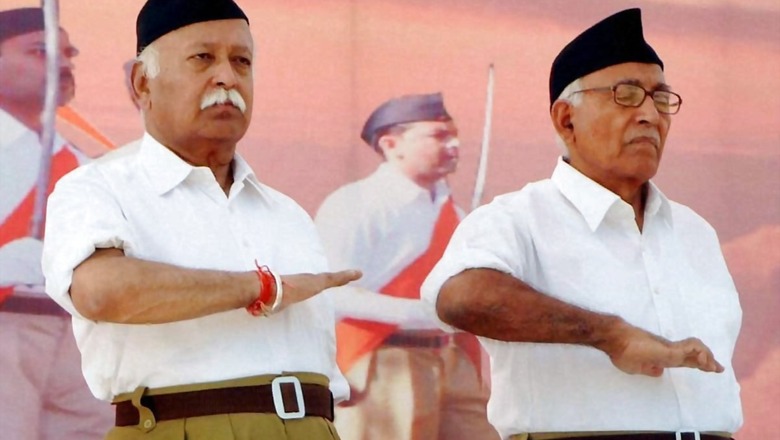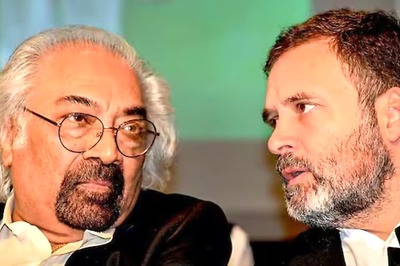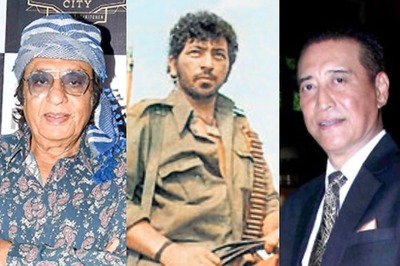
views
The top decision-making body of the Rashtriya Swayamsevak Sangh (RSS), the Akhil Bharatiya Pratinidhi Sabha (ABPS), will meet in Samalkha, Panipat district of Haryana from March 12 to 14 this year. The body meets once every year. These meetings take place behind closed doors so there is always curiosity as to what is being discussed in the meeting, especially since its ideological mentee Bharatiya Janata Party (BJP) has come to power in 2014.
Though there are regular media briefings regarding the ABPS meeting by senior RSS functionaries, even then, many times, journalists and political commentators happen to see smoke even where there is no fire. Rumours become gossip and gossip is turned into news stories by a section of media when it comes to reporting on the ABPS meet. This stems from the fact that as delegates of many RSS-inspired organisations attend this meeting, so does the top BJP brass. But no political or electoral issues are discussed in the three-day ABPS meeting. The focus is specifically on organisational matters.
To make things clearer for those who want to understand the functioning of the RSS, it is important to go back and trace the origin of the ABPS and its evolution over the years.
Origin of ABPS
The ABPS came into existence after the RSS prepared its Constitution in the aftermath of the ban on the organisation in 1948. In March 1950, the body held its first meeting. One of the key tasks entrusted to the ABPS is to elect the Sarkaryavah (General Secretary) of the RSS. In its first meeting, the ABPS delegates elected Bhaiyyaji Dani to the post. Sarkaryavah is the executive head of the RSS who looks after the day-to-day functioning of the organisation. He is elected every three years. On the other hand, Sarsanghchalak is more like a mentor or guide. He is nominated and not elected.
The format of the ABPS meeting has been clear since its inception. The participants discuss issues of national importance and pass resolutions on them. The most important activity that comprised a significant part of the meeting is the presentations made by delegates from around three dozen organisations. These organisations are inspired by the RSS and run by its Swayamsevaks in a wide variety of fields. To name a few of them: Sewa Bharati, Akhil Bharatiya Vanvasi Kalyan Ashram, Vidya Bharati, Bharatiya Shikshan Mandal, Vishva Hindu Parishad, Bharatiya Mazdoor Sangh, Akhil Bharatiya Vidyarthi Parishad, and, last but not the least, the Bharatiya Janata Party. The representatives of these organisations are given around five to 10 minutes each to present any new learning or innovative idea they have implemented over the past year at the organisational level. The idea is to share good practices that can be replicated by others.
The ABPS delegates are elected in every state. Author Ratan Sharda has explained it in his book ‘Conflict Resolution: The RSS Way’, “ABPS is made up of delegates elected by local district-level committees by an electoral college of senior swayamsevaks who have worked for many years in RSS and have taken up some responsibility at some time in the organisation. They elect delegates for ABPS and also Sanghchalak (nominal head of the RSS) of that district. Top members of the state and regional level committees of the RSS are ex-officio members of the ABPS.”
RSS’ full-time workers, known as Pracharaks, who are working at the district or above level, are also part of ABPS. Thus, ABPS has representation from RSS shakhas from all over the country as well as from organisations run by its volunteers. As the RSS footprint expanded in the country, the membership of ABPS has also swelled. Currently, there are more than 1400 delegates who will attend this year’s ABPS meeting.
According to the Constitution of the RSS, “The ABPS shall review the work of the Sangh and lay down its policies and programmes. Sarkaryavah may invite certain categories of workers to attend the meetings of the ABPS. However, such special invitees shall not be entitled to vote.”
“There are certain permanent invitees in the ABPS that include heads of different spheres of Sangh work in Kshetra Karyakari Mandals (Regional Executive Councils) and Kshetriya Pracharak Pramukh (Regional in-charge of full-time workers) and Prant Pracharak Pramukh (State level in-charge of full-time workers).”
The ABPS is supposed to meet at least once a year. Every third year, the meeting is held in Nagpur at the RSS headquarters. The ABPS meeting generally lasts for three days and is attended by the RSS top brass, including the Sarsanghchalak and Sarkaryavah, who preside over it. Several sessions are held during the day where issues are discussed and presentations about RSS activities on the ground are put forward. The meeting reviews organisational activities over the last year, identifies gaps and challenges and does forward planning. The Sarkaryavah also presents a report on the status of the RSS in the meeting, the challenges faced by the nation and the way forward. Based on this report and other discussions, the ABPS passes resolutions on issues that are important and relevant for society and the nation.
The RSS has passed several resolutions on every aspect of national life, such as economic issues, population policy, women empowerment, wars, calamities and natural disasters, national security, India’s foreign policy, social equality, protection of democracy, cow protection, Ram Temple, the status of Hindus as minorities in other countries, etc.
The draft resolutions are finalised by a select group of senior RSS functionaries, several days prior to the ABPS meeting. The subjects are chosen carefully so that the ground realities are taken into account. Most importantly, unlike many other organisations whose resolutions remain on paper only, the RSS follows up most of its resolutions with action on the ground. For example, the RSS had passed a resolution on the Covid pandemic in India. The resolution was both preceded and then followed by massive relief work by the RSS cadres on the ground and was appreciated not only in India, but globally. In May 2022, Twitter’s Chief Executive Officer, Jack Dorsey, donated $2.5 million to an RSS-inspired organisation ‘Sewa International’ for its relief work during Covid. Similarly, in March 2022, the ABPS passed a resolution of creating more work opportunities for Indians to make Bharat self-reliant. It was followed by a significant outreach programme where the RSS volunteers set up hundreds of job-oriented skill development centres across the country.
Conclusion
In a nutshell, if one wants to understand the RSS, it is important to understand the functioning of its highest decision-making body, the ABPS. However, to understand the functioning of the ABPS, one has to leave the ‘political and electoral perspective’ and look purely from the organisational perspective.
The writer, an author and columnist, has written several books including two books on the RSS. He tweets @ArunAnandLive. Views expressed are personal.
Read all the Latest Opinions here



















Comments
0 comment